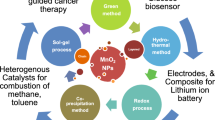Abstract
In this study, pure and Sm3+ doped Fe3O4 nanoparticles were prepared via a microwave assisted synthesis in water solution. The samples were characterized by TEM, XRD, XANES, and VSM techniques. The structure and morphology, Fe and Sm oxidation states, the oxidation resistance and magnetic properties of pure and Sm doped Fe3O4 nanoparticles were studied. TEM and XRD results show that Sm doped Fe3O4 nanoparticles have a good dispersion and are smaller than pure Fe3O4 nanoparticles. The Fe and Sm oxidation states of pure and Sm doped Fe3O4 nanoparticles were studied by means of XANES analysis. The magnetic properties of Sm doped Fe3O4 nanoparticles determined by VSM exhibit superparamagnetic behavior with high saturation magnetization. It was found that Sm doping in a small amount makes it possible not only to reduce the sizes of magnetite nanoparticles but also to improve their oxidation resistance and increase their saturation magnetization value. These pure and Sm doped Fe3O4 magnetic nanoparticles are expected to be used in a number of biomedical applications.
Similar content being viewed by others
References
L. H. Reddy, J. L. Arias, J. Nicolas, and P. Couvreur, “Magnetic nanoparticles: design and characterization, toxicity and biocompatibility, pharmaceutical and biomedical applications,” Chem. Rev. 112, 5818–5878 (2012).
A. K. Gupta and M. Gupta, “Synthesis and surface engineering of iron oxide nanoparticles for biomedical applications,” Biomaterials 26, 3995–4021 (2005).
S. Laurent, D. Forge, M. Port, A. Roch, C. Robic, L. Elst, and R. Muller, “Magnetic iron oxide nanoparticles: synthesis, stabilization, vectorization, physicochemical characterizations, and biological applications,” Chem. Rev. 108, 2064–2110 (2008).
D. Ling, N. Lee, and T. Hyeon, “Chemical synthesis and assembly of uniformly sized iron oxide nanoparticles for medical applications,” Acc. Chem. Res. 48, 1276–1285 (2015).
C. Xu and S. Sun, “New forms of superparamagnetic nanoparticles for biomedical applications,” Adv. Drug Deliv. Rev. 65, 732–743 (2013).
G. Liu, J. Gao, H. Ai, and X. Chen, “Applications and potential toxicity of magnetic iron oxide nanoparticles,” Small 9, 1533–1545 (2013).
H. Markides, M. Rotherham, and A. J. El Haj, “Biocompatibility and toxicity of magnetic nanoparticles in regenerative medicine,” J. Nanomater. 2012, 614094 (2012).
F. Alexis, E. M. Pridgen, R. Langer, and O. C. Farokhzad, Nanoparticle technologies for cancer therapy, in Handbook of Experimental Pharmacology (Springer, Berlin, Heidelberg, 2010).
S. Nie, Y. Xing, G. J. Kim, and J. W. Simons, “Nanotechnology applications in cancer,” Ann. Rev. Biomed. Eng. 9, 257–288 (2007).
J. Klostergaard and C. E. Seeney, “Magnetic nanovectors for drug delivery,” Nanomed.: Nanotechnol., Biol., Med. 8, S37–S50 (2012).
D. Yoo, J. H. Lee, T. H. Shin, and J. Cheon, “Theranostic magnetic nanoparticles,” Acc. Chem. Res. 44, 863–874 (2011).
C. Chouly, D. Pouliquen, I. Lucet, J. J. Jeune, and P. Jallet, “Development of superparamagnetic nanoparticles for MRI: effect of particle size, charge, and surface nature on biodistribution,” J. Microencapsulat. 13, 245–255 (1996).
C. Li, “A targeted approach to cancer imaging and therapy,” Nat. Mater. 13, 110–115 (2014).
J. Xie, G. Liu, H. S. Eden, H. Ai, and X. Chen, “Surface- engineered magnetic nanoparticle platforms for cancer imaging and therapy,” Acc. Chem. Res 44, 883–892 (2011).
W. Huan, C. Cheng, Y. Yang, H. Yuan, and Y. Li, “A study on the magnetic and photoluminescence properties of Eu(n+) and Sm3+ doped Fe3O4 nanoparticles,” J. Nanosci. Nanotechnol. 12, 4621–4634 (2012).
Y. Liu and N. Zhang, “Gadolinium loaded nanoparticles in theranostic magnetic resonance imaging,” Biomaterials 33, 5363–5375 (2012).
W. Wu, Q. He, and C. Jiang, “Magnetic iron oxide nanoparticles: synthesis and surface functionalization strategies,” Nanoscale Res. Lett. 3, 397–415 (2008).
X. Wang, J. Zhuang, Q. Peng, and Y. Li, “A general strategy for nanocrystal synthesis,” Nature (London, U.K.) 437, 121–124 (2005).
W. Zhang, F. Shen, and R. Hong, “Solvothermal synthesis of magnetic Fe3O4 microparticles via self-assembly of Fe3O4 nanoparticles,” Particuology 9, 179–186 (2011).
T. Iwasaki, R. Nakatsuka, K. Murase, H. Takata, H. Nakamura, and S. Watano, “Simple and rapid synthesis of magnetite/hydroxyapatite composites for hyperthermia treatments via a mechanochemical route,” Int. J. Mol. Sci. 14, 9365–9378 (2013).
A. B. Chin and I. I. Yaacob, “Synthesis and characterization of magnetic iron oxide nanoparticles via w/o microemulsion and Massart’s procedure,” J. Mater. Process. Technol. 191, 235–237 (2007).
S. Sun and H. Zeng, “Size-controlled synthesis of magnetite nanoparticles,” J. Am. Chem. Soc. 124, 8204–5 (2002).
D. Ramimoghadam, S. Bagheri, and S. B. A. Hamid, “Progress in electrochemical synthesis of magnetic iron oxide nanoparticles,” J. Magn. Magn. Mater. 368, 207–229 (2014).
C. Li, Y. Wei, A. Liivat, Y. Zhu, and J. Zhu, “Microwave- solvothermal synthesis of Fe3O4 magnetic nanoparticles,” Mater. Lett. 107 23–26 (2013).
B. Ravel and M. Newville, “ATHENA, ARTEMIS, HEPHAESTUS: data analysis for X-ray absorption spectroscopy using IFEFFIT,” J. Synchrotr. Rad. 12, 537–541 (2005).
Author information
Authors and Affiliations
Corresponding author
Additional information
The article is published in the original.
Rights and permissions
About this article
Cite this article
Polozhentsev, O.E., Butova, V.V., Kochkina, V.K. et al. Microwave Assisted Synthesis and Oxidation Resistance of Sm3+ Doped Fe3O4 Nanoparticles. Nanotechnol Russia 13, 109–115 (2018). https://doi.org/10.1134/S1995078018020088
Received:
Accepted:
Published:
Issue Date:
DOI: https://doi.org/10.1134/S1995078018020088




